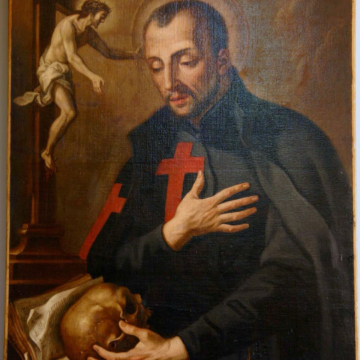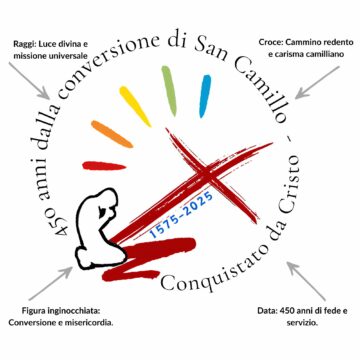Camillus was operating in the second half of the sixteenth century, an age of the great reforms of the cultural movement of humanism and the Renaissance which brought about a notable advance in the scientific, artistic and historical fields, as well as others, but also a profound spiritual and moral crisis.
This is the time when individualism and subjectivism developed. Man established himself above and against the community, with an independent morality and direct personal worship. The man-individual was placed at the centre of the universe and acquired value not for what he was but for what he produced, his material value rather than his spiritual value. It is indubitable that in such a climate, which gave increasing importance to temporal things, the sick, the poor and the needy constituted an obstacle for society. As St. Camillus said to his first religious brothers: ‘Concern for temporal things hinders a spirit of charity towards your neighbour’.
Many ancient hospital religious Orders allowed themselves to be overwhelmed by this climate, giving priority to material goods and receiving commendums, priorships and other economic benefits.
The Catholic Reformation was born in this climate and it found its highest expression in the Council of Trent of 1545. This movement was expressed in action for internal and external renewal, both by saints and the faithful who with prayers and action provided an example of the Christian life.
New foundations took place which acquired the name of ‘Regular Clerics’ and which sought to locate themselves as near as possible to the secular clergy which, above all else, needed reform. They maintained the wearing of habits and shared in the life of apostleship in contact with the faithful but they did not confine themselves, as had been the case in the past, solely to isolating themselves through the practice of the poverty of beggars. They engaged in silent prayer and concerned themselves with specific and important activity of a charitable and social character.
To this reformed climate, which was rich in a vivifying spirit, belonged the foundation by St. Camillus de Lellis of the Regular Clerics, Ministers of the Sick. Surrounded by men whom he trusted and who cultivated his same feelings of charity in serving the sick, he became a reformer of care for the sick.
Camillus and his Company provided service at the Hospital of St. James to begin with and then at the Hospital of the Holy Spirit, but they also brought comfort going through the streets and houses of Rome to find sick people who had been abandoned to their fate.
From Being a Company to Being an Order
When Father Camillus wanted his Company to take the form of the Regular Clerics Ministers of the Sick, all those jealousies and fears felt by the administrators of the hospitals where the Company worked and which had remained bottled up were now unleashed.
The Church had always had, and had at that time, hospital religious Orders made up of laymen, monks and friars who were not priests, in which those ordained in sacris attended to running and administering hospitals and paid very little attention to serving the sick. This activity was limited to those laymen who belonged to the Orders themselves. As a result it was difficult to understand and accept entrusting care for the sick to the Regular Clerics and not to laymen, as had previously been done.
Camillus, indeed, asked his Ministers of the Sick to acquire the dignity of Regular Clerics on the same level as the Orders that existed at that time, such as the Jesuits, the Theatines, the Barnabites and others, that is to say priests who had to live in a community and engage in apostolic activity. This something that was very different from what they had been previously, that is to say a Company of lay nurses, whose existence had never generated opposition of any kind.
To the obstacles that were placed in the way of Camillus, amongst which the charge that he wanted to take over the administration of hospitals through self-seeking care for the sick, this saint replied with a fierce battle and obstinacy in advancing his goal through practical charity. With the weapons of love for his neighbour and the defenceless, as well as rejection of a society that had given over to the delirium of the senses, to money, and to the commercialisation of bodies, Camillus won his battle.
In order not to fall into such venial sin, which had previously affected so many hospital religious Orders that had become more interested in material goods than the welfare of the poor and the sick, Camillus obliged himself and his companions, by means of a vow, not to accept, then as in the future, the management, the running or the administration of Church, civic or lay hospitals, ‘in order to consecrate themselves entirely and with greater purity of spirit and living affection to care for the sick’.
Consistent with his principles he put into practice all of his resolutions and thus spiritual as well as material care for the sick, guided by the very high ideal of charity, became his great cause. This found a place in the heart of the government of the Church. Finally, his Company was raised to being the Order of the Regular Clerics – Ministers of the Sick by Pope Gregory XIV by the Bull for its foundation, ‘Illius qui pro gregis’ of 21 September 1591.
The history of the Order was born at that moment and from then on engaged in a project of reform, always underway, which assured to Camillus de Lellis and his Foundation of the Ministers of the Sick constant life.
Download here the Bull ‘Illus qui pro gregis’ in PDF in the Italian version















Camillians on Facebook
Camillians on Twitter
Camillians on Instagram